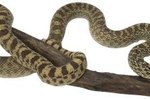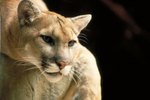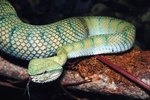
Habitats are constantly changing and evolving, and the animals living within them must constantly adapt to changes large and small. Adaptation can occur broadly, across an entire family of animals, or it can occur very precisely, only developing in a small population within a species. Animals adapt to their environment in a variety of ways; an animal’s color, behavior, defense or diet, for example, may serve adaptive functions.
Color and Pattern Adaptations
Camouflage is an important part of survival for many species, and animals use it to hide from both predators and prey. The color and pattern of an animal usually reflects an animal’s habitat; even within a single species, animals from different habitats can display different colors. The 14 or so species of leaf-tailed gecko (Uroplatus sp.) demonstrate this phenomenon well. Endemic to Madagascar and nearby islands, each species has evolved effective camouflage for its own particular niche; some species camouflage with tree trunks, while others resemble dead leaves of the forest floor.
Behavioral Adaptations
Because behavior can evolve so quickly, behavioral adaptations allow many animals to survive in disturbed habitats. Birds -- especially species that thrive near humans, such as the ubiquitous house finch (Carpodacus mexicanus) -- alter their nesting behavior and often construct their nests on houses and buildings. Adapting to keep up with their prey’s behavior, black rat snakes (Pantherophis alleghaniensis) frequently climb into rafters and buildings seeking shelter and easy food.
Defensive Adaptations
The defensive adaptations of an animal reflect the predatory pressure in their habitat. When this pressure changes, animals adjust their defensive efforts accordingly. Many animals common to parks and urban habitats, such as gray squirrels (Sciurus carolinensis), pigeons (Columba livia) and Canada geese (Branta canadensis), have learned that humans don’t usually represent a threat, and don’t flee as quickly as those living in uninhabited areas do. On a longer timeline, predators and prey compete in an evolutionary arms race; some common prey species for rattlesnakes develop resistance to their venom, which causes the snakes to rely on a different food source, develop venom that is more effective or perish.
Dietary Adaptations
Some species adapt to changing circumstances by varying their diet. Copperheads (Agkistrodon contortrix) display remarkable dietary flexibility. Their food habits not only differ between the five different subspecies, but from one population to the next. Species living in low, damp habitats eat a large number of frogs, while those living in agricultural fields eat rodents and some Texas populations subsist largely on insect larvae.
References
- The Reptile Database: Simple Search: Uroplatus
- Arkive.org: Satanic Leaf-Tailed Gecko
- Cornell Lab of Ornithology: House Finch
- Savannah River Ecology Laboratory: Rat Snake (Elaphe [Pantherophis] Obsoleta)
- Berryman Institute: Managing Problems Caused by Urban Canada Geese
- Toxicon: Resistance of California Ground Squirrels (Spermophilus Beecheyi) to the Venom of the Northern Pacific Rattlesnake (Crotalus Viridis Oreganus): A Study of Adaptive Variation
- Behavioral Ecology: The Influence of Prey-Scent Stimuli on Predatory Behavior of the North American Copperhead Agkistrodon Contortrix (Serpentes: Viperidae)
Photo Credits
-
Karl Weatherly/Photodisc/Getty Images




